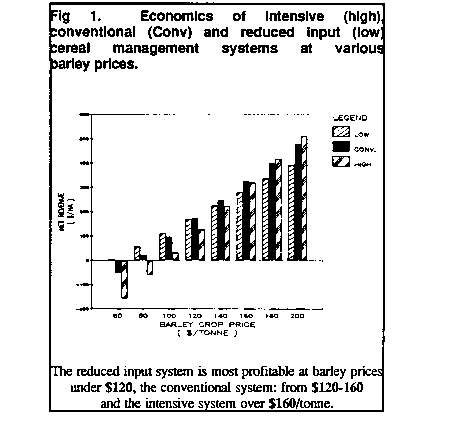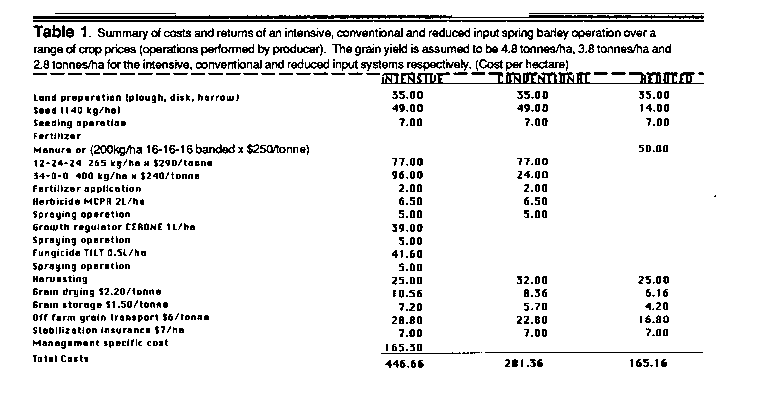
Sustainable Farming Index | Virtual Library | Magazine Rack
Search
| Ecological Solutions Roundtable
A comparative economic analysis of 3 production systems
High input systems of small grain management (also more popularly known as intensive cereal management or ICM) are economically feasible to the producer with the combination of a high yielding environment and high crop price. This is the situation in Europe where ICM has been practiced since the mid 1960's on wheat and the late 1970's on barley. The high European Economic community (EEC) grain subsidies continue to make high input management economically attractive. The situation in Canada is very different. Firstly, our climate is not as conducive to high grain yields even under an intensive management scheme, and secondly, grain is not subsidized in Canada as it is in Europe. Therefore our grain producers get stuck with current rock bottom world grain prices. For these reasons, high input management is not warranted since the extra yield and consequently the extra revenue obtained would not normally be sufficient to cover the variable costs associated with the additional inputs plus costs of application.
Perhaps it is of value here to define intensive cereal management. There are many variations to the system, the simplest consists only of an increased nitrogen fertilizer rate whereas the more complex includes several split applications of nitrogen at particular crop growth stages, two applications of growth regulator for lodging control, two and sometimes three applications of fungicide, insecticide and herbicides, and a tramline system to facilitate the application of these inputs.
This article is intended to shed some light on the comparative economic of intensive, conventional and reduced input grain management systems at the producer level. It must be stressed, however, that every grain producer's situation is different with respect to various variable and fixed costs. The economic analyses presented are meant only to give a general indication of how crop price affects the profitability of these systems. Although barley is the crop used in these analyses, the principles apply to other small grains.
Table 1 show examples of the costs and profitability of the three systems over a range of crop prices for spring barley. This is depicted graphically in Figure 1. A grain yield of 4.8 tonnes/ha (88.7 bu/ac) is assumed for intensive production, 3.8 t/ha (70.2 bu/ac) for the conventional, and 2.8 t/ha (51.7 bu/ac) for the reduced input. The yield response to intensifying inputs is usually not this dramatic but for illustrative purposes, these figures were chosen.

The management specific cost (MSC) is the sum of the variable costs associated with a higher input system over the conventional system normally practiced by a producer. In our examples, the components of this cost are 1) the additional nitrogen 2) growth regulator, fungicide and their applications and 3) increased tonnage for grain drying, storage and off farm grain transport. The increase in yield as a result of intensive management must at least cover the MSC in order to break even. The cost of the extra inputs along with their application totals $162.60/ha (Table 1). With a crop price of $80/t, a producer would require $162.60/ha divided by $80/t, or an extra 2 tonnes per hectare to cover the costs of these inputs. With a crop price of $180/t, a producer would require an extra 0.9 tonnes/ha. Note that the cost of the additional inputs plus application is very close to the MSC in this example. The reason for this is that the lower harvesting costs offset the additional costs for grain drying, storage and transport.
In the case of the reduced input system costs are reduced by band applying lower rates of fertilizer or using manure, bin running seed, not applying a herbicide and lower combining costs due to less lodging. It can be seen from Figure 1 that the reduced input system is most profitable to $120/tonne, the conventional system from $120160/tonne and the intensive management system is desirable only when prices are over $160/tonne. With crop prices approximately $80/tonne today, it would take a 50 and 100% increase in price before the conventional and high input system respectively would become profitable. With the current worldwide grain glut, largely due to the EEC and more recently to the American grain subsidy programs, there is little reason to expect that grain prices will rise appreciably in the next few years.
To be able to compare the economics of the three different systems of management, it is desirable to know the expected yield gain from the higher input system over the conventional system Responses vary with year, region, field and cropping system used by the producer. However, the principle remains the same, the yield must increase at least to cover the costs of the additional inputs considered.
For example, a producer contemplating the use of a higher nitrogen fertilizer rate or who has experienced in the past a problem with crop lodging, may consider the use of a growth regulator. For instance, the addition of Cerone applied at 1L/ha to the current management system would have to account for at least a $39/ha (Cerone) +$5/ha (application) divided by $80/t (crop price) = 0.55 t/ha increment in yield to pay for itself at a crop price of $80/tonne.
The author carried out research on the use of Cerone growth regulator on spring barley at Macdonald College in 1985, a year with favorable growing conditions but with no lodging. Cerone applied up to 1L/ha had no yield effect on Leger, a six-row barley and reduced yields in 2 row cultivars when applied at rates of 0.5L/ha or greater.
Studies performed on a heavy clay soil during a very wet, cool growing season showed that Cerone reduced grain yields, especially of the two-row barley, to such an extent that at 0.5 l/ha the average yield loss was 4%. Therefore, where the crop is stressed due to adverse environmental conditions, Cerone may reduce crop yield and thereby reduce net revenue by more than the sum of its cost and the cost of application.
Nitrogen applied at levels in excess of 100Kg/ha (equivalent to 294 kg 34-0-0/ha) does not usually result in additional yield gains-even in the absence of lodging. This is certainly the case for Quebec as well as central and northern Ontario. In cool, moist maritime climates, a substantial yield response to higher rates of nitrogen is often realized due to the relatively long period in which nitrogen uptake occurs ( from mid-tillering to anthesis). This is especially true of winter cereals. In the warmer and drier late spring and summer of Quebec and Ontario, however, the period of nitrogen uptake is shorter explaining the lack of response to high nitrogen fertility levels.
With current world grain prices, it is highly doubtful that a higher input system would be more economically attractive than a producer's current conventional management practices. However, this does not mean that the producer should necessarily continue with current practices and not consider a lower input approach. With barley prices eat $80/tonne, producers should be trying to find ways to trim input costs rather than increase them.

Editor's note: In the next issue we will identify some low cost systems producers are using to try to turn a profit in touch times.
Copyright © 1987 REAP Canada
Reprinted with permission. All rights reserved.
Info Request | Services | Become EAP Member | Site Map
Give us your comments about the EAP site
Ecological Agriculture Projects, McGill University (Macdonald
Campus),
Ste-Anne-de-Bellevue, QC, H9X 3V9 Canada
Telephone:
(514)-398-7771
Fax:
(514)-398-7621
Email: info@eap.mcgill.ca
To report problems or otherwise comment on the structure of this site, send mail to the Webmaster